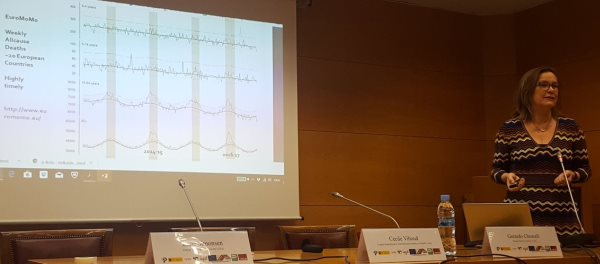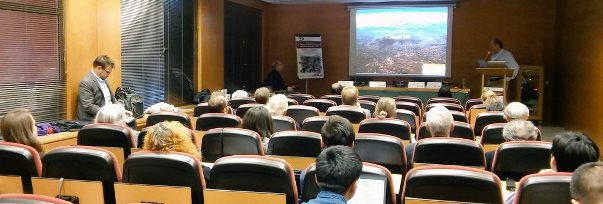IUSSP International Seminar on Pandemics:
Reflections on the Centennial of the 1918 Spanish Influenza Virus
Madrid, Spain, 27-29 November 2017 The International Seminar on Pandemics: Reflections on the Centennial of the 1918 Spanish Influenza Virus was co-organised by the IUSSP Scientific Panel on Historical Demography, the Spanish National Research Council (CSIC), LONGPOP-ITN Project, Fogarty IC/National Institutes of Health (United States) and University of Castilla-La Mancha (Spain) in Madrid, Spain, 27-29 November 2017. The meeting took place at CSIC’s Centre for Humanities and Social Sciences and brought together about 50 scholars to discuss new developments in the study of pandemics in the past with special attention to the 1918 Spanish influenza pandemic. As for previous international seminars organized by the IUSSP Panel on Historical Demography, the seminar was preceded by a training workshop on quantitative approaches to influenza and mathematical modelling of pandemic infectious diseases. Lone Simonsen, Cecile Viboud and Gerardo Chowell, all well respected experts in the field of epidemiological research on influenza pandemics, shared their knowledge on the specifics of the Spanish Influenza – remembered as the worst pandemic in human history – and gave insights on modeling approaches for excess mortality and seasonality patterns. They introduced the Serfling regression model as a method to assess flu mortality and gave lectures on the requirements, strengths and disadvantages of this and other methods. In their introduction, they highlighted the importance for the mapping and analysis of infectious diseases of the number of secondary cases generated by an infected individual, also referred to by its mathematical abbreviation “R”. The extendable SIR model was introduced as a building block to understand the mechanics behind models for spatio-temporal spread or infection periods of pandemic diseases. 
The training session was followed, that afternoon, by the official opening of the Seminar by Diego Ramiro, Chair of the Historical Demography Panel, and the first presentation by Lone Simonsen, who reminded the audience of the severity and spread of the Spanish influenza virus of 1918 and gave an overview of the landmark research on the deadly virus. Her presentation was followed by Cecile Viboud’s on the age at death structure of the 1918 virus, which raised a lively discussion about infant mortality and the localization of the origin of the Spanish influenza. Peter Spreenwenberg closed the first session with a challenging talk on estimations of the number of fatalities. Using Human Mortality Database death counts he emphasized that traditional estimates of the global number of fatalities related to the Spanish influenza might be exaggerated. In a joint evening session with the Demography Today Lecture Series, sponsored by the BBVA Foundation, Cecile Viboud presented measures for influenza mortality and the peculiarities of pandemics with regard to the cause-specific age at death structure. With regard to more recent pandemic events, she also outlined the effectiveness and timing of school closings and other possible interventions. 
The second day started off with the presentation by Tommy Bengtsson on an interesting approach to measure the effects of the 1918 pandemic on the life of individuals who were exposed to the virus through their mothers. Since it was assumed that exposure to the virus at a fetal stage was related to developmental problems regarding mental and physical health, the authors were looking at the economic outcome of these individuals. Apart from a slightly increased mortality, the early flu exposure seems not to have an impact on the flu babies compared to the reference groups. The presentation was followed by a presentation by Sven- Erik Mamelund, who reminded the audience of the importance to reduce socioeconomic inequalities in health. While it was for the longest time assumed that airborne viruses spread equal within a population, more recent contributions show that the Spanish influenza as other pandemic viruses affected deprived areas and less wealthy individuals more than others. He remarked that preparedness plans of the major health organizations and most governments did not take into account the social component. Following this, Enrique Acosta presented his research on the determinants of influenza mortality in the US. Applying an Age-Period-Cohort model, he was able to show that there was a pathological immune response which would confirm the early life exposure hypothesis. By moving to the city level, Donald Olson opened a new perspective. As a member of the New York City Public Health Department, he spoke about the interesting role of pneumonian influenza today and in the past and pointed out the interesting relationship between the 1918 pandemic and the remarkable reduction in tuberculosis deaths in the New York. The next speaker, Laura Cilek, presented the first of her two papers in this session. Operating on a city level, she and her co-authors are working on the identification of spatial and social patterns of the different influenza waves in Madrid. Applying parametric bootstrapping they were able to resample the necessary background mortality patterns which are necessary for the estimation of excess mortality with only one year of base line mortality rates. This was followed by a presentation, Juan Cristina, a molecular biologist, who explained how a virus was built and how it developed over time into different strings. He further presented analyses with newly digitized data from Uruguay’s capital Montevideo. Remaining at the urban level, Laura Cilek presented her second contribution on the city of Madrid. Addressing the socio-spatial differences within the city, she presented an analysis on structural mortality differences at a district level. The next session was opened by Andrew Noymer, who presented the plausible bounds of the death counts of the Spanish influenza virus. Applying demographic backtracking techniques, he was able to show that recent contributions very likely overestimate the number of fatalities around the world. Alphonse MacDonald followed presenting newly discovered data from a colonial census in tropical Suriname. Surprising was the extreme speed with which the virus spread within a country where many areas were not connected through a road network or other ways of transport. He furthermore pointed out that conventional estimations in his country might be too low. The next speaker, Bansal Shweta, presented her research on an influenza epidemic in India, where the highest number of fatalities was to be expected. Based on data from the British colonial records, she showed the particular spatial diffusion of the virus on the subcontinent. Surprisingly, her team found that neither wind nor weather had any impact on the way the flu spread. Another case study using Indian data, more precisely British colonial register data from the Punjab Province, was presented by Ritu Ranolia. She made a case for disentangling fever mortality from flu mortality for particular regions of India and indicated that ill-defined causes of death very probably affected the estimation of flu excess deaths. The strong differences in child and young adult mortality by district seem to support the hypothesis that a malaria outbreak at the time of the 1918 fall wave of influenza had influenced the estimation of flu deaths. The last session of the evening was opened by Howard Phillips, who brought the audience to the Transkei Region in rural South Africa. He skillfully compared the explanatory frameworks and cultural beliefs of the 1918 flu pandemic with the occurrence of HIV in the region in the late 1980s. Even though he found that bio-medical knowledge gained explanatory power over time, the popular beliefs about the ongoing HIV-AIDS epidemic can be retraced to the “black October” of 1918. Evanson Z. Sambala followed with an animated talk on the often unjustified exclusion of Africa from global estimations and projections. Using historical vital statistics, he centered his analysis on the Nyasaland region in Malawi, where the first flu case was detected in November 1918. Within a month the virus had disseminated to the whole region and caused a high death toll within the indigenous population which had never been exposed to a flu virus. Moving back to Europe, Lianne Tripp presented the interconnection between the Spanish Influenza, World War 1, and the Baby boom in Malta. Applying morbidity data for two of the three islands belonging to the island state, she pointed out the importance of related historical events and macroeconomic trends for the estimation of flu deaths. Joelinotahiana Rabarison concluded the second day with a presentation on a surveillance system for flu and respiratory diseases for Antananarivo, the capital of Madagascar. Based on the hospitalized population, the information gained from this statistical infrastructure will be implemented in national health plans. 
The third day of the seminar was opened by Geoffrey Rice. His presentation on how the influenza had affected the Maori population had an interesting take on gender differences between European and indigenous people with regard to health-related behavior. With regard to the flu of 1918, the information remains scarce as it was only collected for Europeans prior to 1920. Returning to an urban setting, Gerardo Chowell presented results on the often neglected pandemic of 1889/90, the so-called Russian flu. As the most outstanding pandemic event in the nineteenth century, the Russian flu arrived in Madrid in mid-December 1889 and, similarly to the 1918 flu, had a very strong winter peak in excess mortality and affected the youngest age groups more than the elderly. The following speaker, Dahal Sushma, who was unfortunately unable to attend in person, video-presented live from Nepal. The focus of her talk was on tuberculosis mortality in the state Arizona (United States), which was found to be not only extremely high in Arizona but also related to the Spanish influenza. Advocating more awareness about regional tuberculosis base rates, Dahal and her team found that the pneumonia and influenza death rates were extraordinarily high in Arizona during the winter wave. Rodolfo Acuña-Soto followed with another interesting example of interrelation between the occurrence of the Spanish influenza and important historical developments of the time. He pointed out that the 1918 influenza virus arrived in Mexico at the worst possible time, since the country was in the middle of a bloody civil war and suffering from a severe draught at the time. The fatality and the immediate spread of the virus had also social implications since it was found to disseminate faster in more deprived regions. Andrew Noymer’s second presentation introduced an alternative way to measure flu mortality by estimating changes in the Gompertz parameters and using age-standardized death rates for pneumonia and influenza mortality. He applied the technique to data on the two pandemics occurring in Hong Kong in 1968 and 2009 and was able to show the “age sparring” effects of the virus. Víctor R. Ocaña-Gutiérrez followed with a different approach to epidemic infectious diseases. Comparing access to e-news on the influenza virus and actual morbidity, he was able to show a correlation between the media coverage and the number of doctor visits. Referring to the data of two flu waves in 2013, he assumed that earlier media coverage of the first wave could have led to a higher awareness and a slower dissemination of the virus. Chwan-Chuen King then presented the impressive effectiveness of the integrated influenza surveillance system of Taiwan, an island state which is supposed to be under high exposure risk to avian flu because of the flyways of wild birds. The system is able to observe irregularities and trend differences within a minimum period of 6 hours. Findings for Taiwan support the hypothesis that more adapted and mutated viruses and not the most common strings will present the greatest risk, especially in high density areas. Benjamin Bob gave the last presentation of the seminar providing great insight into the possible impact of food production techniques on the spread of an influenza virus. He advocated the use of veterinary data to gain more information on how slaughter techniques could help to prevent the spread of avian flu viruses. The seminar was closed by Diego Ramiro with a summary and discussion of possible publication strategies of the rich material presented at the workshop. Read also: |